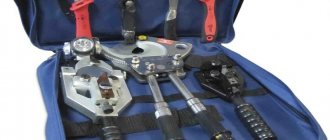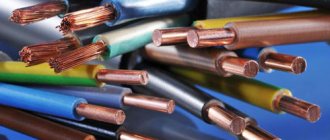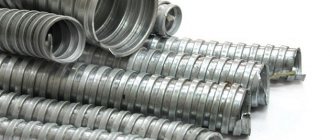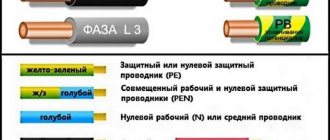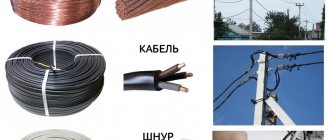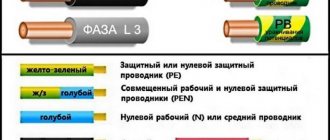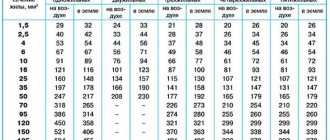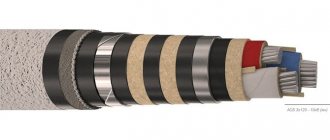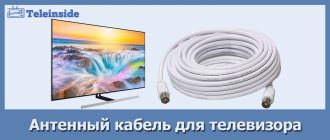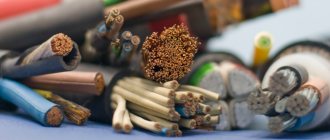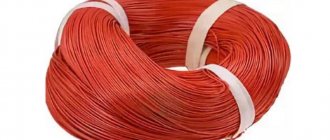Electricity is supplied to consumers and distributed using cable products. The allowable voltage for each wire or cable depends on a number of physical parameters. One of them is the material from which the conductor insulation is made. When the rated voltage increases above 10 kV, the requirements for insulation, both between the cores and the outer shells, become more stringent. High voltage cables with plastic or polyvinyl chloride insulation are being replaced by SPEE cable. The insulation of this product is made of cross-linked polyethylene (XPE).
XLPE insulated cable
Advantages of cross-linked polyethylene
The modern Russian market represents a line of cables and wires with XLPE insulation. Foreign designations for such material are XLPE (England), VPE (Germany), PEX (Sweden).
To identify the advantages of XPE insulation, you need to remember that it can be:
- rubber - a mixture of rubber and additives (fillers, dyes, softeners, vulcanization catalysts, etc.) forms RTI-1 rubber;
- paper with oil impregnation - made of KMP-120 (sulfate cellulose), and the paper always consists of several layers with a thickness of 80, 120, 140, 170 microns;
- plastic - high or low density polyethylene (P) and polyvinyl chloride (PVC).
Important! To give this or that insulation specific properties during production, various impurities are added to the product. They improve the physical parameters of insulation depending on the expected operating conditions.
The advantages of XLPE insulation over the above types of dielectrics include the following:
- a high maximum temperature (2500C) allows you to withstand increased short-circuit currents (short-circuit damage is 15 times lower compared to paper insulation);
- long-term permissible temperatures for XLPE cables are higher (up to 900C), therefore their throughput increases by 1.3-1.5 times;
- manufacturers guarantee a service life of over 50 years without loss of quality indicators;
- absence of lead or aluminum shells, which reduces weight, diameter and bending radius, this simplifies installation during installation;
- the lower limit of sub-zero temperatures when laying without initial heating has decreased by five degrees and is 200C, this is due to the use of polymers;
- XLPE conductors are not afraid of changes in route levels and are dielectrically stable due to their very low hygroscopicity;
- The absence of oil filling makes XPE cables environmentally friendly in case of damage.
Due to the fact that such cable products do not contain liquid components, the cost and time of installation work are significantly reduced. Proper installation of products with cross-linked polyethylene insulation should prevent damage to the outer shell.
Attention! It is unacceptable to secure the conductor with metal clamps without using protective substrates (gaskets). You can use tape bands, polymer cast clamps and other specific fasteners for this.
Installed XLPE cable
Three-phase cables
Various modifications of three-phase cables are produced. In practice, products with separate shielding for each core are most often used. Additionally, they can have one common shield for the entire cable. This combination reduces interference emitted into the external environment.
There is another way of laying. With it, each phase is laid with a separate cable. This method is preferable for powerful conductors with a cross-section of 240 square meters or more. mm, because it is easier to lay 3 thin cables than one thick one. Separate installation of the three phases also has a beneficial effect on the throughput of the line. Wires separated from each other are less susceptible to overheating and are able to pass more current without destruction.
Separate laying of phases with single-core conductors
XPE has increased reliability. It more easily tolerates heat, short circuit currents and the humid environment in the trench. Due to the absence of oil, it is impervious to height differences during installation. Such advantages allow us to achieve uninterrupted operation and an impressive service life of more than 30 years.
At the same time, there are advantages from the point of view of electricians. XPE conductor is easier to work with. It has reduced weight and a smaller bend radius. These factors make it more preferable for installation, the simplicity and convenience of which determines the cost of the work.
Design Features
What is the difference between a cable and a wire?
When approaching melting temperatures, polyethylene insulation loses its qualities: shape, mechanical parameters and electrical characteristics. A temperature of 850C is critical for this type of insulation. XPE can withstand heating up to 1300C without consequences.
For your information. Processing of polyethylene, as a result of which the bonds between molecules change (at the “macro” level), is called “cross-linking”. The three-dimensional structure of cross-links obtained using such vulcanization gives an increase in insulation parameters at all positions.
Molecular three-dimensional structure of XPE
Marking
Symbols used to denote XPE models:
- A - the core is made of aluminum, if there is no letter, then it is made of copper;
- PV - polyethylene insulation;
- P - designation of a layer of polyethylene;
- PU - a layer of high-density polyethylene;
- B - inner PVC layer;
- Vng-Ls - indicates that the shell is resistant to fire;
- 2g - double sealing of the wire.
When purchasing a product, you must read the specification, which fully describes all brands.
Technical characteristics of XLPE cables
Cable VVG PNG (A): decoding
The letter abbreviation of the conductors indicates their brand, device and design options. It includes indices that describe the composition of the materials from which they are made:
- lived;
- core insulation;
- shell.
The numbers indicate the number of cores, cross-section and rated voltage (kV).
Table of letter markings of XLPE cables
An example of such markings, designation and decoding can be seen by referring to the picture below.
Labeling example
Technical characteristics for any brand of product can be viewed in the tables. When considering, it is necessary to take into account the category of networks (according to IEC 60183).
For your information. The tables take into account the minimum cross-sections of the screen, selected according to the values of short-circuit currents (short circuits). As the screen cross-section increases, it is necessary to make allowances for long-term permissible currents; their value decreases.
Technical characteristics of conductors for voltages 6-10 kV
Cables with impregnated paper insulation
These cables are still produced, although you can’t find them in all catalogs; probably, whoever produced them still produces them. And those who haven’t produced it understand that PVC and XLPE are now more in demand and more profitable, due to the absence of heavy lead and other sheaths. Production is based on GOST 18410-73.
If the abbreviation begins with the letter C, this means that the impregnating composition is flowing, otherwise it is viscous.
AABL
— paper insulation impregnated with a viscous composition; current-carrying conductor, single-wire (s) or multi-wire; for voltage 1, 6 or 10 kV (with index C only for 6 and 10 kV); as a screen - a tape of electrically conductive paper;
- A - aluminum core
- A - aluminum shell
- B - armor made of a pair of steel strips
- l - a layer of plastic tapes under the armor in the pillow
- 2l - two layers of tapes in a pillow with armor
AAShv
- A - aluminum core
- A - aluminum shell
- Shv - PVC protective hose
ASB
- A - aluminum core
- C - extruded lead sheath
- B - armor made of two steel strips
TsASPShng
- C - paper insulation impregnated with a non-drip compound
- A - conductive aluminum conductor
- C - lead sheath
- P - armor made of galvanized wires
- Ш - protective cover in the form of a hose
- ng - does not support combustion
Device
The shape of the cores in cables can be round or sector. A sector-shaped current conductor has a number of disadvantages, namely:
- there are no special mechanical tools for cutting such cables; the work is done manually;
- when splicing, cavities are formed in the couplings in the plane of the triangle, which makes sealing the connection difficult;
- the magnetic field arising around the sector has an asymmetry, this leads to an increase in losses.
A 10 kV cross-linked polyethylene cable cannot protect the technical characteristics of which in a three-core version do not withstand installation in the ground without filling the intracavity gaps. Cables with round conductors do not have such disadvantages.
Construction of single-core XLPE cable
Manufacturing of 10 kV cable
In our offers for 10 kV cable the price is
fully justifies the quality of the presented samples. After all, all of them must undergo the strictest certification. It consists of several stages. The first is checking products directly in production on the quality control line. The second is official product certification, which applies to all batches produced by the enterprise. Only on the basis of it can documents of compliance be issued or a refusal issued. The third is a control check of the received batch already at our warehouse center. It involves inspecting samples for damage and verifying documents. Thanks to these verification stages, when you contact us, you can be completely sure that the supply will contain only high-quality samples that meet the technical requirements of your electrical network, because the slightest discrepancy in this matter can lead to failure of all devices.
Application specifics and product classes
Cables with XLPE insulation are used in power system networks where the following conditions must be met:
- transportation of large energy capacities over long distances;
- laying a route on complex relief surfaces;
- ensuring increased requirements for environmental and fire safety.
The main classification of such cable products is carried out based on design features.
Factors determining classification
Features of connection by type of grounding
When making calculations at the design stage of cable laying schemes, the method of connecting the “neutral” to the “ground” is considered. A neutral is a conductor that connects the neutral wires of the windings of supply transformers or generators (in three-phase networks) to one point. There are two types of inclusion of XLPE cables for operation, namely:
- circuit with isolated neutral (IN);
- circuit with a solidly grounded neutral (ZN).
Depending on the type of connection, short circuit protection is provided for the lines. In networks with an isolated neutral, the cable can be operated when one phase is short-circuited to ground (OZZ) for quite a long time. This single-phase fault does not require immediate shutdown for repair. The fault current is small, but causes aging of the cable.
Carefully! OZZ with a solidly grounded neutral requires immediate operation of a protective shutdown. The short circuit current is very high, and the conductor may burn out.
Neutral connection types
How it is produced
In the production of power cables (PC) all over the world, two technologies are used.
The stitching technology is:
- chemical;
- radiation.
The chemical method is divided into two types of production, depending on the reagents that are used in chemical reactions: these are peroxides and silanes.
Peroxides placed in an environment of neutral gases, in combination with a certain pressure and a given temperature, produce a crosslinking effect. It spreads throughout the entire thickness and has no air inclusions. The peroxide method is used to produce cables designed for medium and high voltage.
Important! Before testing, products made with peroxides must be kept for a sufficient time to allow methane to escape from the insulation after cross-linking. Exposure is carried out at a temperature of 800C, under pressure.
Silanes are active surface substances (organic silicon compounds), they stably bind the organic matrix and inorganic fillers. This is a cheaper method in which the insulation is applied to the core in silicic acid. The silane method is used to produce cables operating at low and medium voltages.
Radiation technology, although more efficient, is used for the manufacture of cables for special operating conditions due to residual radiation. It is performed by irradiating polyethylene with hard gamma rays.
Stitching methods
Interesting. The catalyst used in peroxide technology (dicumyl peroxide) has a strong, special odor. It appears when there is an attempt to mechanically destroy the insulation. Insects and rodents do not tolerate it, which is a good defense against attacks from gnawing animals.
Pros and cons of the peroxide method
Cables with XLPE insulation began to be put into operation since the middle of the last century. The Japanese were pioneers in this. Today, such products designed for medium voltage account for 80 to 95% of the total volume in the USA, Canada, Denmark and Germany. Japan, France, Sweden and Finland brought this figure closer to 100%. Russian manufacturers of energy products have also set a course for producing such reliable conductors.
Types of insulating materials XLPE
Cross-linked polyethylene can be produced using different technologies with changes in temperature, pressure of the reaction taking place, as well as accompanying substances. In this case, materials are obtained that differ slightly in their properties. The electrical insulation industry uses:
- PEXb is polyethylene, “cross-linked” using the chemical silane (or silanol) method. In its production, hydrogen silica substances are used, which, with an increase in temperature to 80-90 C, participate in hydrolysis, connecting the side branches of polymer macromolecules. A relatively cheap method, it gives about 65% cross-linking. It was very common at the initial stage of using polyethylene as cable insulation, but it gave an uneven distribution of properties throughout the entire volume.
- PEXa “crosslinks” in the presence of hydrogen peroxide, which is why it is called “peroxide”, when the temperature rises to 400 C and the pressure is 8-9 atm. This method of modifying polyethylene is more complex and expensive, but it gives up to 80% of cross-linked molecules and a relatively uniform distribution of indicators over the volume of the material. It is most widely used as high-voltage insulation of large thickness.
ATTENTION! At the moment, PEXb insulation is only permitted for cables rated for voltages not exceeding 1 kV. At higher voltages, it has lower electrical resistance, often breaks down and quickly becomes unusable.
To insulate wires of 10-35 kV or more, only PEXa material is used!
